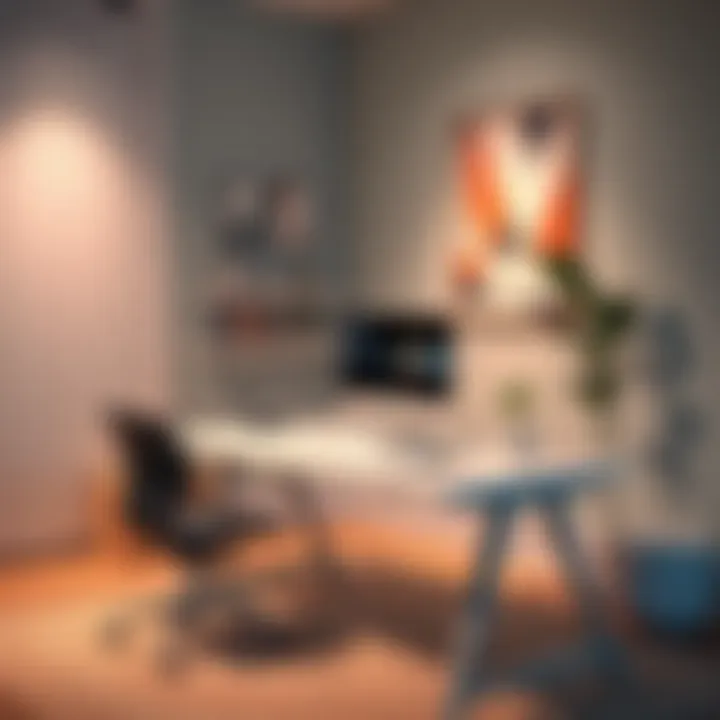Discovering Local Desks: Your Ultimate Buying Guide


Intro
In today’s fast-paced world, a desk is more than just a piece of furniture; it's an essential hub where ideas are born, tasks are tackled, and productivity is nurtured. As we navigate through various styles and functionalities, finding the right desk could feel akin to searching for a needle in a haystack. However, this guide aims to slice through the noise, providing a comprehensive look at the types of desks available in local markets, their unique characteristics, and insights into making an informed choice.
Furniture Trends
Current Design Trends
The desk you choose speaks volumes about your work ethic and personal style. Currently, there’s a noticeable swing towards multi-functional designs. Desks that can transform from a sitting to a standing desk not only promote better posture but also accommodate a more dynamic work style. Moreover, materials play a significant role. Natural woods like oak and walnut are gaining traction, often paired with sleek metal bases to create a striking contrast.
Another trend is the minimalist approach, where simplicity reigns. Desks with clean lines and uncluttered surfaces are popular among homeowners seeking to create calm, organized spaces. In fact, some modern designs blur the lines between desk and decor, incorporating bookshelves or storage solutions directly into the desk’s structure.
Popular Color Palettes
When it comes to color, neutrals such as soft greys and muted whites dominate the scene, allowing for easy integration into various design schemes. Some people, however, lean towards bolder choices like deep blues or rich greens, injecting energy into what might be a dull corner. Wood finishes are trending away from the traditionally dark tones, moving towards lighter, even bleached looks that create an airy feel in any room.
"The right color palette can transform not only the desk but also influence your mood and productivity!"
Practical Tips
Furniture Maintenance and Care
Maintaining a desk isn’t just about cleaning; it’s an art form. Regular dusting prevents dirt build-up, especially on those lovely wooden surfaces. Depending on the material, a periodic polish can bring out the beauty in the grain of the wood. For surfaces that are painted or laminate, a simple damp cloth often does the trick. Remember to steer clear of harsh chemicals that might damage the finish.
Space Utilization Strategies
Choosing the right desk also involves strategic thinking about space. An L-shaped desk might be ideal for those corners of your room that often go underutilized. For smaller spaces, consider a wall-mounted desk. This type of desk provides functionality without eating up valuable floor space. Arranging your desk with complimentary decorative items can create a well-rounded atmosphere that’s functional yet aesthetically pleasing.
In the end, whether you’re a seasoned designer, a DIY enthusiast, or just someone looking to spruce up their work-from-home environment, understanding the myriad of options available is paramount. By knowing current trends and practical tips, you can select a desk that not only meets your needs but also enriches your workspace, creating an enjoyable environment to accomplish your goals.
Prelims to Desks
When embarking on the journey of selecting a desk, it's essential to understand that a desk is much more than just a piece of furniture. The desk serves as the hub of productivity, a place where ideas come to life and tasks are accomplished. Its design, style, and functionality can have a significant impact on how effectively you work, whether in a home office or a corporate environment. This section lays the groundwork for the ensuing exploration by delineating what defines a desk and its overall purpose in our daily lives.
Definition and Purpose
A desk typically refers to a piece of furniture with a flat surface for writing, reading, or holding various items necessary for work or study. One might think a desk’s sole purpose is to support a computer or a stack of documents, but the reality is much broader. Desks can enhance organization, contributing to a clean and efficient workspace. In a sense, they are the stage upon which the drama of productivity unfolds. Furthermore, a well-chosen desk can promote better posture and encourage ergonomic practices, ensuring comfort during long hours of work. This is particularly crucial in today’s flexible working arrangements, where individuals may find themselves spending more time at their desks than ever before.
Historical Overview
The evolution of desks traces back several centuries, with wooden writing tables used in ancient Egypt and Greece serving as some of the earliest forms. Originally, desks were simple structures, designed primarily for writing and reading. Over time, they have morphed into diverse forms, reflecting changes in work styles and technological advancements.
In the Middle Ages, desks were typically massive, ornate pieces, built for both functionality and status, often found in wealthy homes and monasteries. The Industrial Revolution brought about significant changes; desks became more ubiquitous and were manufactured in various styles to accommodate needs across different sectors. The rise of the office culture in the late 19th century led to the emergence of specialized desks designed for clerical work.
Fast forward to today, desks have evolved dramatically with the integration of technology. Now, they come equipped with built-in cable management and adaptable surfaces to accommodate computers and other digital devices. This rich history underscores the importance of understanding not only the functional aspect of desks but also their culturally significant roles in shaping workspaces throughout history.
"A desk is more than a workstation; it's a crucial part of the ecosystem of focus and creativity."
In essence, learning about the history of desks provides context to our modern choices, helping us appreciate the significance of design elements and their functional attributes in creating personalized work environments.
Types of Desks
When it comes to choosing the right desk, understanding the diverse types available is fundamental. Each type serves a distinct purpose and adapts to particular needs and preferences. As people increasingly work from home and integrate technology into their daily routines, selecting the ideal desk can influence both productivity and comfort. Whether you're sinking into a long writing session or diving into a creative task, the right desk can make all the difference.
Writing Desks
Writing desks are tailored for those who need a dedicated space for jotting down notes or crafting the next great novel. Typically, these desks are minimalistic with just enough surface area to hold your essentials: a notebook, a few pens, and perhaps a cup of coffee to fuel your thoughts. Many designs focus on ergonomics, enhancing comfort during lengthy writing sessions.
Benefits of Writing Desks:
- Simplicity: Their unadorned designs keep distractions at bay, allowing for a focused environment.
- Affordability: Generally more budget-friendly compared to multi-functional desks.
- Space-Saving: They often have a smaller footprint, making them ideal for tight spaces.
Moreover, a writing desk can serve as an elegant addition to your home decor, showcasing your literary ambitions.
Computer Desks
Computer desks are a staple in modern homes, particularly with the rise of technology-hungry tasks. They are specially designed to support computers, laptops, and all the accessories that come with them. These desks may feature integrated cable management systems, shelving units, and even storage drawers.
Considerations for Computer Desks:
- Ergonomics: Look for adjustable models that let you customize the height for comfortable viewing.
- Surface Material: Whether you prefer wood, metal, or glass, the material affects not just aesthetics but also durability.
- Furnishing Your Workflow: Arranging monitors, keyboards, and other gadgets efficiently can enhance your workflow significantly.
A well-chosen computer desk can enhance both the style of your space and your work efficiency.
Executive Desks
Executive desks often command a sense of authority, designed for executive offices and high-visibility workspaces. These desks are usually larger, made from premium materials, and often boast intricate designs. They’re not just for work; they exude status and professionalism.
Key Features of Executive Desks:
- Functionality: Ample surface area to accommodate papers, devices, and more allows for organized chaos.
- Craftsmanship: Often made from high-quality woods, these desks present an elegance that speaks volumes about the owner.
- Storage Options: Most designs come with built-in cabinets and drawers to keep documents secure yet reachable.
Ultimately, it's about creating an environment that promotes not just work, but a certain gravitas that can influence meetings and gatherings.
Standing Desks
With the growing awareness of health impacts tied to prolonged sitting, standing desks present a refreshing alternative. These desks allow you to easily switch between sitting and standing positions, fostering a more active work lifestyle.


Benefits of Standing Desks:
- Health Advantages: They encourage better posture and can reduce the risk of certain health issues related to extended sitting.
- Increased Energy: Users often report feeling more energized and alert while working from a standing position.
- Flexibility: Many models are adjustable, fitting into various environments and accommodating different user heights.
Embracing a standing desk could be a game-changer, blending health with productivity.
Corner Desks
Corner desks make excellent use of space, especially in smaller offices or home setups. They maximize often-overlooked corners, providing a spacious work area without encroaching too much on the room's floor plan. These desks allow for an immersive workspace that can keep everything organized within arm’s reach.
Advantages of Corner Desks:
- Space Efficiency: Perfect for fitting snugly into corners, freeing up the rest of the room.
- Comfort: Users often find themselves enveloped by the desk arrangement, creating a cocoon-like environment that fosters concentration.
- Additional Surface Area: Many designs come with extended surfaces or shelves, accommodating multiple monitors or documents.
In summary, understanding the various types of desks allows for informed choices that enhance both aesthetic appeal and functionality, catering to the specific needs of homeowners, designers, and DIY enthusiasts alike.
Desks and Their Functions
Understanding the functions of desks goes beyond mere aesthetics or style. In the modern workspace—whether at home or in a corporate environment—the desk plays a pivotal role in shaping productivity and employee well-being. Designers and users alike need to appreciate how desks impact everyday tasks, workflow, and even mental health.
A proper desk setup can lead to increased efficiency, as it directly influences organization and accessibility. Consider this: when everything from your laptop to your notepad is within easy reach and arranged in a way that minimizes clutter, you will find yourself working more fluidly. With the right desk, productivity doesn’t feel like a stretch; it becomes a natural extension of your daily routine.
Integration with Technology
In an age where technology is at the forefront, the desk must seamlessly integrate with an array of electronic devices. Think about it for a moment—the average desk isn't just a flat surface anymore; it’s an operational hub. Having a dedicated space for computer monitors, printers, and charging stations is essential in maintaining order. Moreover, the increasing necessity for power outlets and USB ports cannot be overlooked.
For instance, brands like Flexispot and IKEA have started integrating built-in charging capabilities into their desks, reducing wire clutter significantly. Users who remain connected to their devices are more likely to perform at optimal levels. Additionally, smart desks like those from Uplift provide features like automated height adjustments and memory settings which enhance user experience and foster a more ergonomic work environment. By adopting such innovations, your workspace can keep pace with your tech-driven lifestyle.
Adaptability for Remote Work
The rise of remote work has profoundly changed how we perceive desks. No longer are they just fixtures in a static office; they must now adapt to suit various needs, whether for video calls or focused tasks. This adaptability is crucial as it allows individuals to customize their workspace to their preferences.
When selecting a desk for remote work, consider the following elements:
- Adjustable height: Facilitates standing or sitting as per comfort, which is essential for long hours of work.
- Storage options: Desks that include shelves or drawers can help keep personal items and office supplies organized.
- Mobility: Desks on wheels or those that can be easily reconfigured lend flexibility to your work setup.
A well-chosen desk for remote work essentially transforms the home environment into an effective workspace. Embracing this flexibility reflects a broader trend toward individual autonomy in workspaces, where employees prioritize comfort and productivity above traditional office norms.
"A workspace should inspire creativity, drive focus, and mitigate physical strain."
Design and Aesthetics
Design and aesthetics play a crucial role in not only the selection of desks but also in enhancing the overall ambiance of spaces. Whether at home or in an office, a desk isn't merely a functional piece of furniture; it serves as a foundation for creativity, productivity, and style. An aesthetically pleasing desk can seamlessly integrate with its surroundings, making a statement that reflects personal taste while fostering an environment conducive to work.
A well-designed desk contributes significantly to efficiency. Factors such as color palettes, materials, and overall design ethos can impact mood and motivation. For instance, vibrant colors may energize a workspace, while muted tones promote calmness and focus. Thus, understanding the nuances of design and aesthetics offers valuable insights for homeowners, designers, and DIY enthusiasts alike.
Moreover, aesthetics also brings to the forefront the importance of quality. Desks that combine aesthetic appeal with durability often become timeless investments. Therefore, enticing potentials reflect on both visual and tactile elements. With that in mind, let’s delve deeper into the specifics.
Contemporary Styles
When discussing contemporary styles, one can’t help but notice the shift toward minimalism that has taken the design world by storm. Sleek lines, open spaces, and a lack of clutter characterize these modern desks. For example, a floating desk can provide a sense of openness while still offering essential workspace. Materials like engineered wood and powder-coated metal create a high-tech yet warm feel, which harmonizes wonderfully with current lifestyle preferences.
Another interesting trend in contemporary design is the use of bold geometric shapes. Desks that break away from traditional rectangles and squares captivate attention. These designs inspire creativity, making workspaces more than just a place for tasks; they become sources of inspiration.
Traditional Influences
On the flip side of the spectrum, traditional desk designs hold a certain charm that appeals to many individuals seeking a classic look. These desks often incorporate rich woods like mahogany or oak and may feature intricate carvings and robust structures. Notably, designs such as roll-top desks evoke nostalgia and lend an air of sophistication to home offices.
The enduring nature of traditional designs stems from their durability and craftsmanship. These desks typically emphasize functionality combined with an elegant aesthetic, often with features like multiple drawers and surfaces that accommodate various tasks. Traditional desks often exude a sense of history and character, connecting the user with eras gone by.
Customization Options
Customization is a major selling point for many modern desks. With countless options available, homeowners can tailor their desks to fit not only the dimensions of their space but also their style preferences. From choosing the type of wood to hardware finishes, custom desks can catch the eye while catering to specific functionality.
Some manufacturers even offer modular designs that allow users to adjust their desks according to their changing needs. This adaptability might include adding or removing sections, different surface textures, or even adding integrated technology for charging and cable management.
In summary, design and aesthetics make a significant impact on the experience of working at a desk. By combining elements from contemporary styles, traditional influences, and endless customization options, buyers can find or create a desk that not only meets their needs but also enhances their workspace.
"A well-designed desk can transform a mundane area into a vibrant hub of productivity and creativity."
For more insights on desk aesthetics and design trends, you can explore resources such as Britannica or engage with design communities on Reddit.
Ergonomics in Desk Design
When it comes to selecting the right desk, ergonomics plays a pivotal role. Creating a workspace that promotes health and efficiency isn't merely a matter of preference; it's about making informed choices that can lead to improved productivity and well-being. In this section, we will explore the significance of ergonomics in desk design, highlighting specific elements, benefits, and important considerations.
Importance of Ergonomics
Ergonomics, at its core, is about designing a workspace that suits the user’s needs. The desk acts as a central hub for various activities, be it writing, computing, or even crafting. An ergonomic desk setup can significantly reduce strain on the body.
Moreover, long hours in front of a computer or a desk can lead to issues such as back pain, neck strain, and repetitive strain injuries. By choosing a desk that incorporates ergonomic principles, users can:
- Enhance Comfort: Proper desk height and layout alleviate physical discomfort.
- Promote Better Posture: Encouraging users to sit or stand correctly helps prevent long-term health issues.
- Increase Productivity: A comfortable workspace allows for longer focus periods without the distraction of discomfort.
In essence, integrating ergonomic solutions into desk design is not just a trend; it's a necessity, especially in a world where remote work is increasingly prevalent.
Features to Look For


When shopping for an ergonomically designed desk, keep an eye out for specific features that can make a world of difference. Here’s a rundown of essential elements you should consider:
- Adjustable Height: Look for desks that offer adjustable heights to accommodate sitting and standing positions. This flexibility encourages movement and reduces the risks associated with prolonged sitting.
- Spacious Surface Areas: Ample desk space can prevent clutter, allowing users to spread out materials comfortably and maintain an organized work area. This feature is particularly useful for designers and DIYers who often have multiple tools and materials at hand.
- Keyboard and Monitor Placement: An ergonomic setup should allow the monitor to be at eye level, while the keyboard should be positioned so the elbows remain at a 90-degree angle. Desks with built-in keyboard trays can be particularly beneficial here.
- Cable Management Systems: Desks with cable management features keep cords organized and out of the way, ensuring that your workspace remains clean and distraction-free.
- Material and Construction Quality: A well-constructed desk made from durable materials can strongly influence comfort and usability. Ensure the desk surface feels good to touch and stands resilient against wear and tear.
"Investing in an ergonomic desk isn’t just about comfort; it’s about creating a workspace that brings out the best in your productivity."
By focusing on these features, you create a workspace that not only meets your needs but also anticipates them. Selecting the right desk equipped with the essential ergonomic elements can save headaches—literally and metaphorically—down the road.
Materials Used in Desk Construction
Understanding the materials that go into desk construction is essential for anyone in the market for a new workspace. The choice of materials influences not only the durability and aesthetic appeal of the desk, but also its functionality and environmental footprint. Selecting the right materials can enhance comfort, support productivity, and align with personal or corporate values regarding sustainability.
Wood Varieties
Wood remains a classic choice for desk construction, offering both beauty and functionality. Different types of wood, such as oak, maple, walnut, and pine, feature distinctive characteristics that affect durability, grain pattern, and overall appearance.
- Oak is renowned for its strength and resistance to wear and tear, making it a popular choice for desks that see heavy use. Its beautiful grain adds a touch of elegance to any workspace.
- Maple tends to be lighter in color and is less dense, which can make it easier to move. Despite its softer nature, maple is known for its fine texture and is somewhat resistant to scratches, which is a consideration for those looking to maintain a fresh appearance.
- Walnut provides a rich, dark hue that adds a touch of sophistication. Though it can be more expensive than other woods, its luxurious aesthetics and robust profile often justify the price for discerning buyers.
- Pine is often favored for budget-friendly options. It is lighter and can be easily finished to match existing decor, although it is less durable than hardwoods.
Each wood type brings unique advantages, and understanding these can help buyers make informed decisions based on their individual preferences and needs.
Metal and Glass Designs
For a modern, industrial look, metal and glass are often the materials of choice. These options symbolize strength and minimalism, appealing to those who appreciate sleek designs.
- Metal frames are becoming increasingly popular, especially with the rise of standing desks. They provide structure and stability, making them ideal for adjustable models. Materials like steel and aluminum are often used due to their strength and resistance to corrosion.
- Glass surfaces offer a contemporary flair. They can create a light, airy feel in any office while providing a functional work surface. However, one must consider additional care—fingerprints and smudges can be glaringly visible, necessitating regular cleaning to maintain the pristine look.
- Combining metal and glass can result in striking designs that stand out in home or office settings, though it’s essential to ensure that the materials chosen also complement existing décor.
Sustainable Materials
In an increasingly eco-conscious world, sustainable materials are becoming a preferred choice for many shoppers. Consumers are often looking for desks made from materials that reduce environmental impact and provide renewable options.
- Bamboo, for example, is a rapidly renewable resource that’s durable and stylish. Its unique grain adds a modern touch to desks while being strong enough for daily use. It’s also naturally resistant to moisture, making it an excellent choice for various environments.
- Reclaimed wood offers not only sustainability but also character. Using wood that has been repurposed from old buildings or furniture can tell a story and reduce waste in landfills, aligning perfectly with the values of ethical consumers.
- Eco-friendly composites and finishes also play a significant role in sustainable desk construction. Products that use recycled materials or low-VOC (volatile organic compounds) finishes help to maintain indoor air quality and minimize exposure to harmful chemicals.
In summary, the materials used in desk construction have a profound effect on aesthetics, durability, and environmental impact. By considering the distinct qualities of wood, metal, glass, and sustainable choices, individuals can thoughtfully select desks that meet their functional needs and reflect their values.
Influence of Space on Desk Selection
Choosing a desk isn't just a question of personal preference; it's deeply tied to the spaces we inhabit, be it a bustling office or the cozy corners of a home. The layout, size, and function of the area play a pivotal role in determining what kind of desk will suit your needs well. Understanding these spatial influences can save you time, enhance productivity, and create a workspace that truly feels like your own.
Office Environments
In corporate settings, the type of desk you select can directly impact not only your productivity but also the office's overall aesthetic. Factors such as desk dimensions, arrangement, and style must be aligned with your workplace's design language. For example, an open-plan office may require modular desks that can be rearranged easily, fostering collaboration among coworkers. On the other hand, private offices might lean towards executive desks, showcasing authority and professionalism.
- Ergonomics is Key: Workspaces should include desks that cater to the physical needs of the workers. Adjustable height options allow individuals to tailor their setup for comfort.
- Accessibility: It's crucial to consider cable management and accessibility to plug sockets. If your workspace is cluttered with wires, it might lead to not just a messy appearance, but potential safety hazards.
"The right desk can transform the daily grind into a more seamless experience, making tasks seem less daunting while improving overall efficiency."
Home Office Considerations
The surge in remote work has led many to rethink their home office setups. Utilizing available space creatively becomes essential. For small spaces, compact desks that maximize surface area without imposing can be a great fit. A slim writing desk placed against a wall can create an efficient workspace even in tight quarters. Meanwhile, larger homes can afford spacious desks, ideal for dual-monitor setups or creative projects.
- Personal Touches: Home offices generally provide more freedom for personalization. Surrounding your desk with items that inspire or motivate—be it art or plants—can enhance your working environment considerably.
- Lighting Matters: Good lighting is another critical component. Desks close to windows can take advantage of natural light while those away from it might need stylish desk lamps with adjustable brightness.
Ultimately, the influence of spatial considerations cannot be overstated when selecting the right desk. By taking into account the specific needs of the office environment or your home office setup, you can choose a desk that fits seamlessly into your life, both practically and aesthetically.
Budgeting for Desks
When it comes to selecting the perfect desk, one cannot gloss over the importance of budgeting. Establishing a clear financial plan empowers you to make informed choices, ultimately leading to a purchase that meets both your aesthetic desires and practical needs. Understanding how to allocate your funds is essential. While some may view a desk merely as a workspace, the right one can elevate productivity and enhance the overall atmosphere of your home or office.
There are several factors to consider when budgeting for your desk:
- Purpose: Think about what you'll use the desk for. Is it for working on a laptop, crafting, or maybe doing paperwork? Different functionalities require different features, which can affect the cost significantly.
- Quality: Higher quality materials and construction generally lead to a longer lifespan. Investing in durable desks can save money in the long run.
- Design: The style of desk you choose is likely to influence the budget. For example, a minimalist Scandinavian desk may cost less than a traditional executive style with ornate details.
- Space Considerations: Think about the dimensions of your workspace—smaller spaces may require unique designs that could come at a premium.
With all these variables at play, establishing a precise budget tailored to your needs is vital in avoiding overspending.
Cost Breakdown by Type
Different types of desks come with their own price tags, and knowing the cost breakdown can help you strategize better. Here’s a glance at what you might expect to pay:
- Writing Desks: These range from approximately $100 to $500, depending on material and brand. A simple wooden writing desk can be budget-friendly, while designer pieces will likely push you to the higher end of the spectrum.
- Computer Desks: Generally, these fall between $150 and $600. If you require additional features such as built-in cable management or adjustable heights, this will influence the cost.
- Executive Desks: These can vary widely, starting at around $300 and reaching up to $2,000. Custom finishes and heavy-duty materials will elevate the price.
- Standing Desks: Expect to spend anywhere from $250 to $1,200. The higher-end models offer electric adjustments and more sophisticated mechanics.
- Corner Desks: Depending on features and size, a corner desk usually ranges from $150 to $700.
This cost variation among types stresses the need for homeowners and office managers alike to clearly define what features they prioritize.
Investment versus Value
When pondering desk purchases, it’s useful to differentiate between the concept of investment and the value of your buy. An investment implies a higher upfront cost for something expected to yield benefits over an extended time. On the other hand, value suggests the overall utility and satisfaction gained from the expenditure.
- Long-Term Benefits: Spending a bit more on a quality desk can reduce the need for replacement and maintenance in the future. Consider an ergonomic standing desk that promotes better posture and reduces health issues associated with prolonged sitting—it might seem like a significant upfront cost, but your well-being is priceless.
- Personal Satisfaction: A desk that complements your style and enhances productivity adds intangible value that cheaper options might not bring. Feeling comfortable can dramatically improve your efficiency.
- Consider Resale Value: A well-maintained piece can yield good returns if you decide to sell later. Remember that some desks, especially from reputable brands, retain value better than others.
"A penny saved is a penny earned—but a well-spent penny can lead to countless hours of productive comfort."
For further information on budgeting and desk selection strategies, you might find the following links useful:
- Wikipedia - Office desk
- Britannica - Desk
- Reddit - Desk recommendations
- Facebook - Home Office Ideas Group
By carefully planning your budget and considering the price versus value, you can make an educated decision that suits your lifestyle.
Shopping for Desks Locally


Shopping for desks in your local area holds great significance, especially as many individuals are putting more thought into their workspaces. This act of local shopping extends beyond mere convenience; it encompasses the opportunity to support small businesses, touch the products firsthand, and understand the overall quality before making a purchase.
Visiting local stores allows you to engage directly with knowledgeable staff. These professionals can provide insights that may not be available through online descriptions. Plus, having the chance to see the desk in person can clarify size, color, and design elements far better than any photograph might convey.
Benefits of Shopping Locally
- Immediate Availability: You can take your desk home right away, eliminating long wait times for shipping.
- Personalized Service: Local retailers often pride themselves on customer support, offering tailored advice based on your specific needs.
- Community Support: By choosing local retailers, you contribute to the local economy and help maintain the character of your neighborhood.
Understanding what you need before making a local trip can lead to a more focused and efficient shopping experience. Make a list of features you desire, as well as the styles that appeal to you. This approach minimizes aimless wandering in stores and can speed up your decision-making process.
Local Retail Options
Exploring local retail options can open your eyes to a wide array of desks suited for various purposes. From stores like IKEA, which provides budget-friendly options, to boutique furniture shops that might offer unique, high-end selections, the choices can cater to every taste and requirement.
In addition, many local stores might even have showrooms that allow you to try out desks before committing. You could discover that a desk you originally thought would be perfect doesn’t quite fit your ergonomics or aesthetic preferences once you sit at it.
Tip: Take note of measurements in your space before you visit. Many desks are striking in the showroom but may feel cramped in a smaller home office.
Online Marketplaces
While local shopping has its perks, don't overlook the convenience and variety that online marketplaces offer. Platforms such as Amazon or Wayfair can help expand your search significantly. These sites provide user reviews, detailed product information, and often a broader selection than you would find in any single store.
However, balance is key. Ensure you weigh the pros and cons of purchasing online versus finding that perfect desk locally. When browsing online marketplaces, take the time to read customer feedback—it can often shed light on quality issues that may not be apparent through marketing photos.
"Reading the reviews was the tipping point; I discovered hidden flaws in models I considered perfect."
Desk Maintenance and Care
Maintaining your desk is as important as purchasing one that fits your style and needs. A well-cared-for desk not only enhances the aesthetics of your environment but also extends the life of the furniture. In this section, we will explore key elements of desk maintenance, focusing on cleaning procedures and necessary repairs. This guidance will be invaluable for homeowners, designers, DIY enthusiasts, and real estate agents seeking to impress clients or elevate their own workspaces.
Cleaning Procedures
Keeping your desk clean might seem straightforward, but there’s a bit more to it than just wiping it down with a cloth. The first point to consider is what materials your desk is made from.
For wooden desks, always use a damp cloth instead of a soak one, as excess moisture can warp the wood. A solution of mild soap and water can be an effective way of removing dirt and grime. Remember, avoid harsh chemicals as they can remove the finish and dull the wood's natural beauty.
Here are some steps to consider:
- Dust Regularly: Use a microfiber cloth to capture dust particles rather than spreading them.
- Deep Clean Monthly: Mix a solution with vinegar and water to sanitize the desk's surface — just be sure to test it on a less visible spot first.
- Finish Preservation: Consider applying a furniture polish specifically designed for the type of wood you have. This will keep the wood nourished and looking pristine.
- Handle with Care: Always place coasters or mats on your desk if you’re putting down drinks or hot items. This prevents stains and heat damage.
"A clean desk makes for a clear mind and boosts productivity in ways you can’t measure directly."
For metal or glass desks, a soft cloth and glass cleaner work wonders. Be cautious with metal, as scratched surfaces can lead to rust. Glass requires constant attention for fingerprints and smudges that can distract you.
Repair Considerations
No matter how well you care for your desk, wear and tear is inevitable. Addressing repairs promptly can save you from more significant problems down the road. Here’s what to look out for:
- Loose Hardware: Regularly check and tighten screws on any assemblies. If a drawer creaks or doesn’t open smoothly, it could indicate loose fittings.
- Surface Scratches: If you have a scratch on your wood desk, a designer wood filler can do the trick. For minor scratches, a simple walnut can help. Rubbing it on the scratch may fill it in effectively.
- Chair Marks: If your office chair leaves marks on a wooden desk, consider using a gentle cleaner followed by a nourishing oil or polish.
- Glass Chips: For glass surfaces, minor chips can be avoided with proper usage. In case of more severe damage, professional glass replacement might be necessary.
Small repairs can usually be handled at home, but if major structural issues arise—especially with older furniture—it’s worth consulting a professional. Investing in repairs often outweighs purchasing a new desk, especially if it's a piece of quality craftsmanship.
By investing time in maintenance and repair, your desk can not only remain functional but also continue serving as a beautiful centerpiece in your workspace. Care ensures that your desk will continue to support your endeavors, whether at home or in the office.
Future Trends in Desk Design
As workplaces evolve, the choices of desks follow suit. Understanding future trends in desk design is crucial for anyone considering what to invest in, especially homeowners, designers, and DIYers. These trends not only reflect aesthetic changes but also signal shifting needs in functionality and productivity. The focus is on creating spaces that enhance creativity, comfort, and efficiency, ensuring that each desk serves its purpose holistically. With the advent of technology, the landscape is more dynamic than ever.
Smart Desks
The rise of technology has paved the way for smart desks, a concept that might sound futuristic but is steadily becoming mainstream. These desks integrate technology seamlessly into their structure. Think about features like adjustable height settings, built-in charging ports, and even Bluetooth connectivity. By melding hardware with digital tools, smart desks offer a personalized workspace tailored to individual preferences.
Benefits of adopting smart desks include:
- Health Monitoring: Many models come with health-tracking features that remind you to stand or take breaks, helping combat the adverse effects of prolonged sitting.
- Efficiency: Extensions like a wireless charging surface or an app-controlled height adjustment can streamline your workflow and keep your space clutter-free.
- Aesthetic Appeal: Sleek, modern designs accompany smart functionality, making them visually attractive in any setting.
However, while considering a smart desk, it's vital to think about compatibility and power sources. Ensure that your desk can interact effectively with existing gadgets. To give it legs to stand on, a balanced selection of smart desks is available, like the Vari Electric Standing Desk or the Flexispot E7 Pro Plus, known for their innovative features and customization options.
"The workplace is not just a place to work; it's an environment that can nurture growth and well-being."
Innovative Materials
Innovative materials in desk design are not merely about aesthetics; they are often an extension of sustainability and functionality. Designers are now looking beyond traditional wood and particle board, embracing materials that reflect modern sensibilities. The materials range widely from recycled plastics to bamboo and metal composites. Each serves a purpose, balancing durability with environmental impact.
Here are a few noteworthy materials gaining popularity:
- Bamboo: Known for its rapid renewability, bamboo offers a sturdy yet lightweight option that appeals to eco-conscious consumers.
- Recycled Materials: Desks made from recycled components reduce waste, promoting sustainability and appealing to environmentally aware buyers.
- Metal and Glass: Sturdy yet elegant, metal framework with glass tops is on the rise, offering a sleek, contemporary look that can fit diverse styles.
Incorporating such materials not only reflects personal values but also addresses durability and sustainability in use. As consumers become more educated, the market is aligning with these narratives, influencing future desk production and design.
As the workspace continues to shift and adapt to our changing lifestyles, the need for understanding these trends is paramount. A well-informed decision can enhance not just how one works, but where one works.
Ending
Drawing the curtains on the exploration of desks, it’s essential to distill the key elements that surround this often-overlooked piece of furniture. Desks serve not only as functional surfaces for work but also as an embodiment of one’s personal style and workspace efficiency. In essence, investing in the right desk transcends mere preference and delves into the realms of productivity, well-being, and smart design.
Recap of Key Points
Reflecting on this guide, we’ve traversed various facets of desk selection:
- Types of Desks: From writing desks to standing desks, each variety brings its own advantages. Selecting wisely can influence how effectively you work.
- Functionality and Design: The integration of technology and adaptability for remote work remains crucial today. The desk should complement both your tasks and aesthetic preferences.
- Ergonomics: Understanding the importance of ergonomics ensures comfort. Features like adjustable heights can significantly improve your posture and reduce strain.
- Materials: The choice of wood, metal, or even sustainable materials can impact not only durability but also the eco-friendliness of your workspace.
- Space Considerations: Different environments—be it a compact home office or a sprawling corporate space—require tailored desk designs to maximize utility.
- Maintenance: Care and upkeep of your desk can lengthen its life, enhancing your investment in a piece that should stand the test of time.
- Future Trends: The upcoming innovations in desk design, especially smart technology, suggest an evolution where functionality meets creativity.
Final Thoughts on Desk Choices
Choosing a desk is more than simply picking a surface to put your laptop on. It demands thoughtful consideration of your habits, health, and aesthetic preferences. Think about how you use your desk day-in and day-out.















